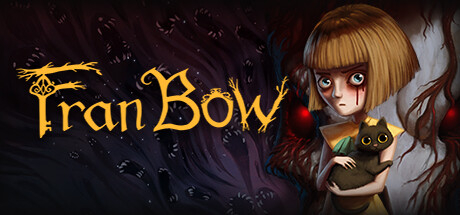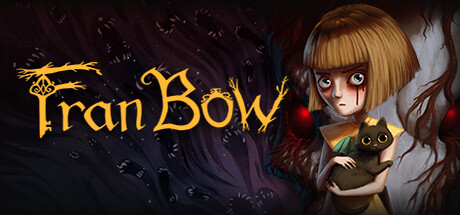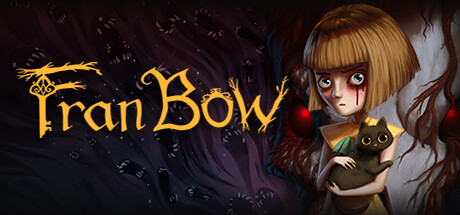
Fran Bow (XOne) - Review
by Lee Mehr , posted on 30 May 2023 / 2,681 ViewsOf all the classic stories within the public domain, Lewis Carroll's Alice in Wonderland has earned a longer shelf life for both its malleability and distinguished features; the trope of a girl (or young woman) stumbling into an alternate reality is broad and flexible, but her Victorian-era dresswear – that iconography – is specific. Whether talking about vacuous blockbusters that hollow out any sense of the original's themes like the live-action retelling or more interesting efforts like American McGee's Alice series, that template has found traction across different artistic mediums. Now with Killmonday Games' spin on the template coming to consoles, it's worth asking this question: should you venture down the rabbit hole?
The year is 1944. The 10-year-old title character has been committed to an asylum after witnessing the grisly murder of her parents. She's been separated from her best friend, a black cat named Mr. Midnight, as a result of being institutionalized too. These horrific experiences and Fran's diminishing mental fortitude push her psychiatrist to administer a new pharmaceutical drug. But hallucinatory experiences from this medicine further spurns her to escape this madhouse, find her cat, and ultimately return home.
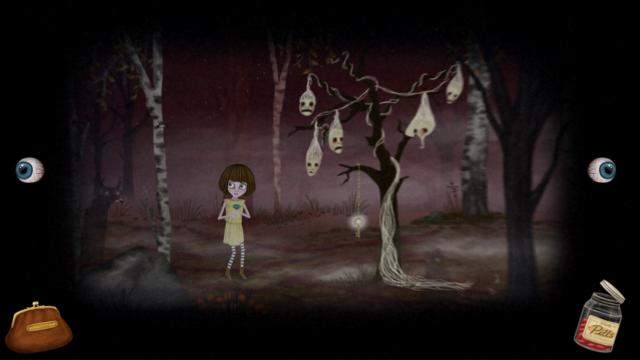
From the very start, Fran Bow is unapologetically adult content. Even before introducing these suspicious drugs, the story begins with monochromatic 2D still-frames detailing the horrors Fran witnessed and the image of her crying blood. It's a mere primer to the grotesque imagery waiting for her after gulping down some Duotine. Think of it like putting on/taking off the special glasses from They Live: her normal lens sees other child wards as depressed husks until this other reality reveals them as half-rotted skeletons with haunting apparitions clung onto them, casually discussing their past trauma. While free of that burden, Fran still deals with horrifying stuff in either reality. One repugnant adult is willing to give a quest item in exchange for "sitting on his knee" to give him a kiss. Fortunately, the only way past this is an alternate solution.
The macabre scenery intersects with the childlike tone Fran still gives off, like her closest inspiration. Beyond her striped stockings and straight jacket refashioned into a casual dress, she also carries herself with era-appropriate mannerisms. Even when making a strong rebuke she'll typically button it with a "sir" or "ma’am." Besides acting initially horrified when in Pill Vision, Fran typically keeps her head on straight in the sight of uncomfortable horrors. She's one to go towards a deformed, two-headed baby asking if they’re alright instead of darting to the nearest exit. That impetus helps keep the player invested; if a 10-year old can handle horrors beyond comprehension so can you.
Such horrors tend to hit more visually than narratively. Sure, it's easy to spot technical shortcomings with stretching out the image beyond a typical PC or phone screen: a subtle graininess to the dialogue font and basic UI. But the effort poured into this twisted hand-drawn world leaves a lasting impression, especially when you’re wondering how twisted a new place will look before jumping to the alternate version. Although this initially carries a good shock effect, the jaunt through Bloody Wonderland loses some of its bite towards the end. To avoid spoiling as much as possible, Natalia Martinsson's exploration of this twisted childhood has good intentions, but starts losing itself with an ambiguous ending more interested in tossing in an abundance of different characters than answering pertinent questions.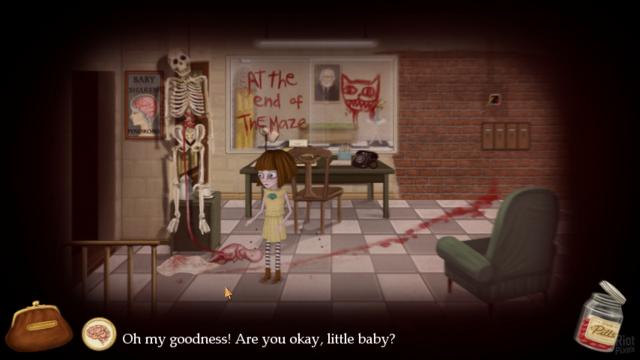
These trappings are wrapped into a point-n-click adventure package, for better and worse. Fran Bow sticks close to the baseline template: scan the little controller-cursor over anything in sight, explore the scenery as much as possible, and all inventory items follow the Use/Combine/Examine trilogy. Most conundrums are enjoyable. Not only is the alternate horror dimension there for gory visuals but also for opening locked paths or finding quest items; however, that nuance can also be a double-edged sword. Now instead of soaking in the atmosphere your mind is more intent on simply flipping between worlds for a hairpin or a medallion. The haunting sights and sounds lose their magic if you're hurriedly hopping between them to move past a puzzle that's stumping you.
It's worse for wear with its mechanics than puzzle design however. While still a pet peeve of mine, at least the controller-cursor is snappy by default and customizable. A more serious complaint would be 90s adventure tropes like consistently clicking on interactable objects until Fran's dialogue or internal thoughts repeat – signaling you've attained all necessary information. And while there are a few nice controller shortcuts for navigation, it can't avoid the extra downtime in selecting inventory items and matching them with the environment. Finally, the useless dialogue system: you're either selecting between two flavors of the same answer or a response that moves the dialogue forward or cuts it short with a goodbye. I'd rather see what writers would put in the protagonist's mouth in these scenarios. These are more than quibbles too since they add to its lumpy pacing.
This collection of paper cuts is more a sign of distracting from good puzzles than signaling terrible design. Another great benefit of the Wonderland setting is the potential to re-think established norms and logic. By weaving that with mental illness, it complements the weirder combinations you might make. That's not to say players have to approach everything like 1+1=Rocky Road Ice Cream, but rather that there's sense in the madness. That doesn't disregard some of its more flagrant brainteasers. Taking a detour from pill-popping freak shows to a dainty fantasy world results in a nice change of scenery, but also one particular puzzle based on an item that never tells you its full capabilities. A few puzzle duds and terrible gameplay changeups bookending each chapter (like a low-grade 2D runner segment) never ruin genuine engagement, but do distract from its better ideas.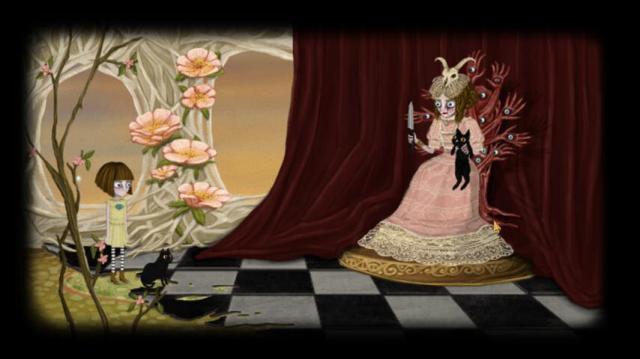
Value is a straightforward affair: $20 for approximately 8 hours (likely more). While I don't want to undersell that amount of work, especially from a 2-person team who've certainly gone to great lengths to port and simultaneously ship this onto last-gen consoles, it's fair to question the intrinsic value of the experience itself over a dollar-per-hour evaluation. That becomes a tougher quality to measure.
Fran Bow is nothing else if not intriguing. The sheer amount of vile & traumatic sights this young girl is put through could be seen as cheap shock value, but Killmonday Games' artistic sincerity suggests those accusations have little merit. At the same time, this drug-fuelled trip through Wonderland is hampered by rough qualities ranging from a lackluster ambiguous resolution to obnoxious point-n-click trappings dating to the Triassic period. It's a frustrating mixture of impressive and lackluster qualities that kept me invested, even if never thoroughly satisfied. A prescription I can't recommend to everyone.
Contractor by trade and writer by hobby, Lee's obnoxious criticisms have found a way to be featured across several gaming sites: N4G, VGChartz, Gaming Nexus, DarkStation, and TechRaptor! He started gaming in the mid-90s and has had the privilege in playing many games across a plethora of platforms. Reader warning: each click given to his articles only helps to inflate his Texas-sized ego. Proceed with caution.
VGChartz Verdict
6
Decent
This review is based on a digital copy of Fran Bow for the XOne
More Articles
SPOILERS AHEAD!
Superbly-worded review! Fran Bow is a game I think I liked a bit better back when it was new than I do now, but I will say that I definitely don't find its narrative too subjective. Here's my Fran theory:
Given all the game's allusions to mental illness, I think a happy, literalist interpretation of the narrative is just not serious. In reality, Fran has always been a living experiment who consequently murdered her family and even beloved Mr. Midnight. Her mental state 'improves' gradually in the sense that her visions become calmer as she progresses through the game. But the five realms, Ithersta, all that is not actually real and Fran is, in truth, still chained to her bed in the asylum as the game concludes, having lost touch with reality because she couldn't handle it in the end. Like the more interesting spins on Alice, Fran Bow is a tale of descent into madness. That's the crux of how I read it.
Anyway, the shock value of the game's visuals has waned a bit for me over time (I feel like Fran myself now a lot of the time that way; like oh, that's my head out there. sighs Give me back my head. :P ) and the puzzle-based nature of it keeps things firmly in the psychological horror camp. It's the introspection here that keeps Fran Bow a frightening tale. Inner demons can be much scarier than imagining real ones, believe me.
Thanks, Jaicee. Greatly appreciated.
That's a grounded interpretation, but I'd also dislike if that was the definitive one if only for seeing Fran mentally broken by the end. My taste have slightly shifted the more I see horror films, games, etc. relying on nastier endings versus a somewhat satisfying closure. Feels kinda "torture porn-y" when it comes to a child too. Maybe there's some wiggle room in the happy final minutes being a twisted type of acceptance?
I wouldn't be surprised if I look kinder on Fran Bow in the future though. Because I think what you're spelling is the type of creative kindling that's worth re-appraisal. That said, I still wish how the successive events unfolded weren't so... sloppy.
-"Haha! My son (essentially the prince of darkness) has been picking on you. Now go through here to say hi!"
-"Hey it's me! The one picking a tortured child the whole time! Anyways, hello and goodbye! Head to the next room."
-"But it was all me! I, random character you've just met, behind your troubled mental state. Let me detail a few things about my motivations."
There's something particularly annoying about that sequence of events. I could practically feel my engagement become more and more diminished in real time.
Well that's probably why the conclusion and overall reading of the narrative are left technically subjective; so as those too bummed out by the plausible interpretation have an alternative way of viewing it they can live with. But the bottom line really seems to be that, as they say, ignorance is bliss. Fran is a curious girl who wants both the truth and happiness, but the connection between the two things may be finite. Perhaps for her, dissociation (or madness if you prefer that term; disconnection from reality is what it means) is preferable. It's happier.
But yeah, it may also help to bear in mind the scale of the development team and the time frame and environment in which the game was originally created and the fact that many of the games characters are obviously meant to symbolize aspects of Fran's mental state. To me, one of the things that stands out about Fran Bow is that everything feels like it's symbolic of something in some way; that everything feels important, like it has a meaning you're supposed to decipher. There's nothing that seems like it's just filler material.
Still, Fran Bow shows its age to me when I replay it now. Some aspects of the direction feel more arbitrary than carefully thought out. It all has meaning, but it's not all structured in a convincingly organic way.
























